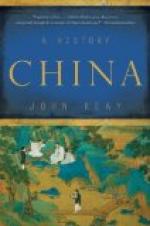The greatest literary achievements, however, of the Mongol period belong beyond question to the theatre (or, rather, opera). The emperors were great theatre-goers, and the wealthy private families were also enthusiasts, so that gradually people of education devoted themselves to writing librettos for the operas, where in the past this work had been left to others. Most of the authors of these librettos remained unknown: they used pseudonyms, partly because playwriting was not an occupation that befitted a scholar, and partly because in these works they criticized the conditions of their day. These works are divided in regard to style into two groups, those of the “southern” and the “northern” drama; these are distinguished from each other in musical construction and in their intellectual attitude: in general the northern works are more heroic and the southern more sentimental, though there are exceptions. The most famous northern works of the Mongol epoch are P’i-p’a-chi ("The Story of a Lute"), written about 1356, probably by Kao Ming, and Chao-shih ku-erh-chi ("The Story of the Orphan of Chao “), a work that enthralled Voltaire, who made a paraphrase of it; its author was the otherwise unknown Chi Chuen-hsiang. One of the most famous of the southern dramas is Hsi-hsiang-chi ("The Romance of the Western Chamber"), by Wang Shih-fu and Kuan Han-ch’ing. Kuan lived under the Juchen dynasty as a physician, and then among the Mongols. He is said to have written fifty-eight dramas, many of which became famous.
In the fine arts, foreign influence made itself felt during the Mongol epoch much more than in literature. This was due in part to the Mongol rulers’ predilection for the Lamaism that was widespread in their homeland. Lamaism is a special form of Buddhism which developed in Tibet, where remnants of the old national Tibetan cult (Bon) were fused with Buddhism into a distinctive religion. During the rise of the




